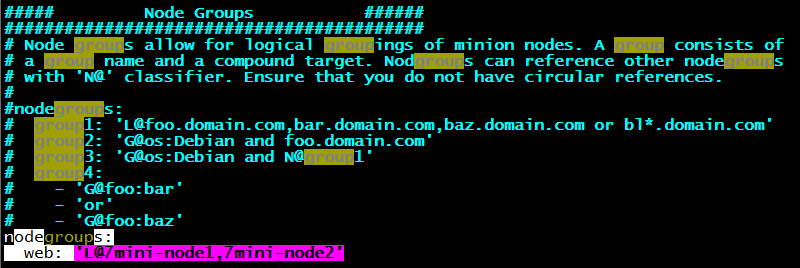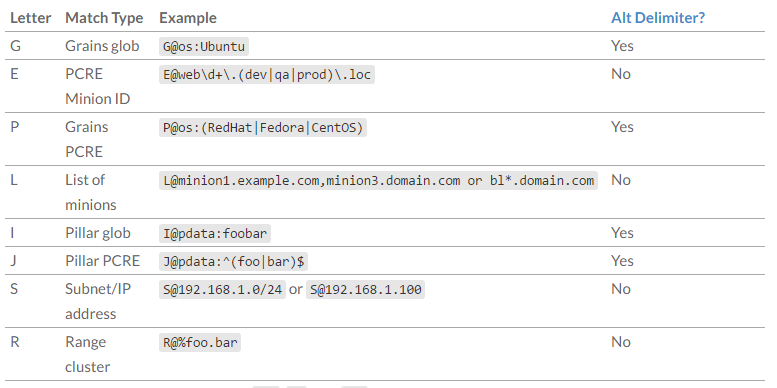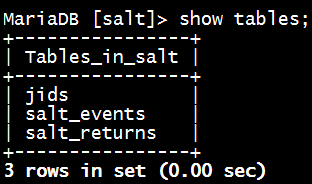Saltstack远程执行(四)
- Saltstack远程执行
语法例:salt '*' cmd.run 'w'
- 命令:salt
- 目标:'*'
- 模块:cmd.run,自带150+模块,也可以自己写模块
- 返回:执行后结果返回,Returnners组件
一.SlatStack远程执行--目标
1)、和Minion ID相关的目标匹配方式
官网文档:https://docs.saltstack.com/en/latest/topics/targeting/index.html
两种定位方法:一种和minion ID有关,一种和monion ID无关
1)minion ID有关的方法
指定具体的minion ID
salt '7mini-node2' test.ping
通配符
salt '*' test.ping salt 'linux-node2*' test.ping salt 'linux-node[1|2].example.com' test.ping salt 'linux-node[1-2].example.com' test.ping salt 'linux-node[!2].example.com' test.ping salt 'linux-node?.example.com' test.ping
正则表达式
salt -E 'linux-(node1|node2)*' test.ping salt -E 'linux-(node1|node2).example.com' test.ping
备注: 所有匹配目标的方式,都可以用到top file里面来指定目标。
minion ID设置方案:IP地址、根据业务来进行设置
例: redis-node1-redis04-idc04-h5web.example.com redis-node1 # redis第一个节点 redis04 # 集群 idc04 # 机房 h5web # 业务线
(2)和Minion无关匹配
1、Grains匹配
[root@linux-node1 ~]# salt -G 'os:CentOS' test.ping
linux-node2.example.com:
True
linux-node1.example.com:
True
2、子网、IP地址匹配
[root@linux-node1 ~]# salt -S '192.168.56.0/24' test.ping
linux-node1.example.com:
True
linux-node2.example.com:
True
3、Pillar匹配
[root@linux-node1 ~]# salt -I 'apache:httpd' test.ping
linux-node2.example.com:
True
linux-node1.example.com:
True
3) Node Groups分组,需要配置master文件
vim /etc/salt/master

重启systemctl restart salt-master
[root@7mini-node1 ~]# salt -N web test.ping
7mini-node1:
True
7mini-node2:
True
4)各种混合匹配(用的比较少)
官方文档 https://docs.saltstack.com/en/latest/topics/targeting/compound.html

批处理 ,可用于重启所有主机或进程场景,百分比或固定数量的一点一点重启主机或进程
官方文档 https://docs.saltstack.com/en/latest/topics/targeting/batch.html
二、执行
官网文档 https://docs.saltstack.com/en/latest/ref/modules/all/index.html#all-salt-modules
列出salt所有模块,以及如何使用的帮助文档
通过yum默认安装salt所有模块存放路径 /usr/lib/python2.7/site-packages/salt/modules(centos 7)
例:
salt '*' network.active_tcp # 列出所有主机运行的tcp连接 salt '*' network.arp # 列出所有主机arp salt '*' service.available sshd # 列出所有主机sshd salt '*' service.get_all # 列出所有主机的所有运行服务 salt '*' service.status sshd # 列出所有主机sshd运行状态 salt-cp '*' /etc/hosts /tmp/test # 将master上/etc/hosts文件拷贝到所有主机的/tmp/test salt '*' state.show_top # 查看top salt '*' state.single pkg.installed name=lsof # 所有主机安装lsof
3、返回程序
官方文档 https://docs.saltstack.com/en/latest/ref/returners/index.html
1)将返回写入mysql库,是由minion直接写入mysql库 #不常用
所有minion安装python mysql模块
两种方法安装MYSQL-python salt '*' state.single pkg.installed name=MySQL-python 或 salt '*' cmd.run 'yum install MySQL-python -y'
创建salt库
CREATE DATABASE `salt` DEFAULT CHARACTER SET utf8 DEFAULT COLLATE utf8_general_ci; USE `salt`;
创建表
-- -- Table structure for table `jids` -- DROP TABLE IF EXISTS `jids`; CREATE TABLE `jids` ( `jid` varchar(255) NOT NULL, `load` mediumtext NOT NULL, UNIQUE KEY `jid` (`jid`) ) ENGINE=InnoDB DEFAULT CHARSET=utf8; CREATE INDEX jid ON jids(jid) USING BTREE;
-- -- Table structure for table `salt_returns` -- DROP TABLE IF EXISTS `salt_returns`; CREATE TABLE `salt_returns` ( `fun` varchar(50) NOT NULL, `jid` varchar(255) NOT NULL, `return` mediumtext NOT NULL, `id` varchar(255) NOT NULL, `success` varchar(10) NOT NULL, `full_ret` mediumtext NOT NULL, `alter_time` TIMESTAMP DEFAULT CURRENT_TIMESTAMP, KEY `id` (`id`), KEY `jid` (`jid`), KEY `fun` (`fun`) ) ENGINE=InnoDB DEFAULT CHARSET=utf8;
-- -- Table structure for table `salt_events` -- DROP TABLE IF EXISTS `salt_events`; CREATE TABLE `salt_events` ( `id` BIGINT NOT NULL AUTO_INCREMENT, `tag` varchar(255) NOT NULL, `data` mediumtext NOT NULL, `alter_time` TIMESTAMP DEFAULT CURRENT_TIMESTAMP, `master_id` varchar(255) NOT NULL, PRIMARY KEY (`id`), KEY `tag` (`tag`) ) ENGINE=InnoDB DEFAULT CHARSET=utf8;
授权
grant all on salt.* to salt@'%' identified by 'salt@pw'; FLUSH PRIVILEGES;

配置minion文件
vim /etc/salt/minion mysql.host: '10.0.0.11' mysql.user: 'salt' mysql.pass: 'salt@pw' mysql.db: 'salt' mysql.port: 3306
重启 systemctl restart salt-minion
测试

salt '*' test.ping --return mysql

salt '*' cmd.run 'df -h' --return mysql

2)使用salt的job_cache机制将命令写入mysql(常用方法)
执行的所有命令都会写入mysql,不用使用return,把cache写在mysql
[root@linux-node1 ~]# vim /etc/salt/master
master_job_cache: mysql
mysql.host: '192.168.56.11'
mysql.user: 'salt'
mysql.pass: 'salt'
mysql.db: 'salt'
mysql.port: 3306
[root@linux-node1 ~]# systemctl restart salt-master
[root@linux-node1 ~]# salt '*' cmd.run 'w'
[root@linux-node1 ~]# mysql -uroot -p123456 -e "select * from salt.salt_returns;"
#加上-v参数可以看到jid,并且通过jid可以查看运行的结果
[root@linux-node1 ~]# salt '*' cmd.run 'uptime' -v
Executing job with jid 20180118095000725560
-------------------------------------------
linux-node2.example.com:
09:50:00 up 14 days, 4:24, 2 users, load average: 0.00, 0.01, 0.05
linux-node1.example.com:
09:50:00 up 23 days, 3:56, 2 users, load average: 0.00, 0.06, 0.18
[root@linux-node1 ~]# salt-run jobs.lookup_jid 20180118095000725560
linux-node1.example.com:
09:50:00 up 23 days, 3:56, 2 users, load average: 0.00, 0.06, 0.18
linux-node2.example.com:
09:50:00 up 14 days, 4:24, 2 users, load average: 0.00, 0.01, 0.05




 浙公网安备 33010602011771号
浙公网安备 33010602011771号